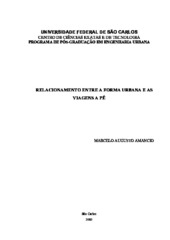Relacionamento entre a forma urbana e as viagens a pé.
Abstract
The objective of this dissertation is to verify if there is a relationship between
the characteristics of the urban form and option for walking trips.
For this relationship to be studied, the first step was a bibliographic review
about the urban form characteristics that might influence the option for walking.
Among the methodologies that could be used to evaluate the modal option, a
logit-type Discrete Choice Model, was chosen. The data used for the calibration of the model
were collected in São Carlos, SP, a Brazilian medium-sized city with around 200 thousand
inhabitants. The analyses were developed at census tract level, with a Geographic Information
System (TransCAD).
Two logit-type models were calibrated. The first one (basic) includes only a
socio-economic variable (automobile availability) and the trip length. The second model
(expanded) includes, besides the variables of the basic model, information about the
characteristic of the urban form in the trip origin sectors.
The comparison of the results obtained with the two models, allowed the
evaluation of the marginal influence of urban form variables on the mode choice. In general,
the expanded model was statistically better then the basic one. The results suggest that urban
form characteristics do influence the individuals´ option for walking.
